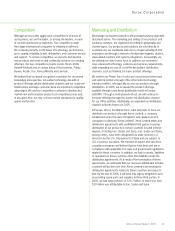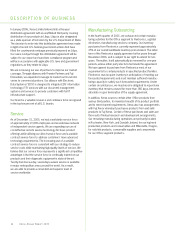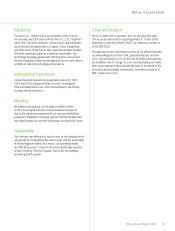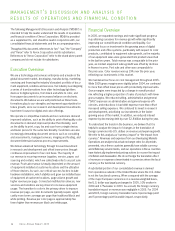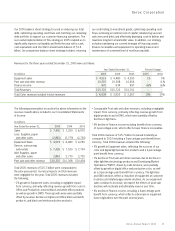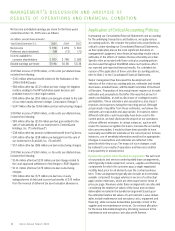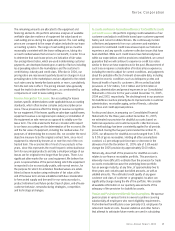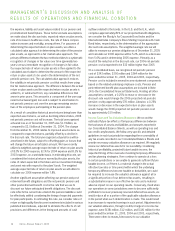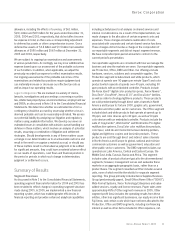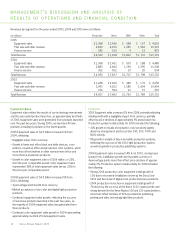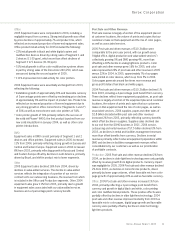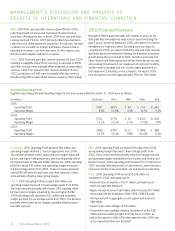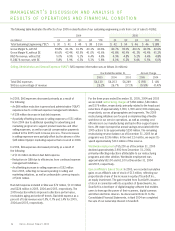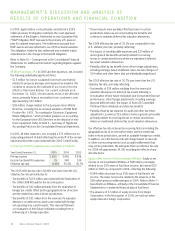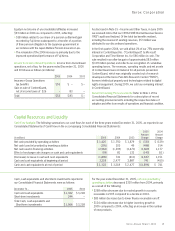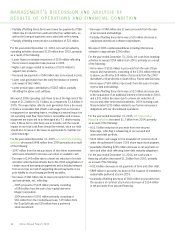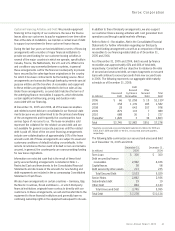Xerox 2005 Annual Report Download - page 39
Download and view the complete annual report
Please find page 39 of the 2005 Xerox annual report below. You can navigate through the pages in the report by either clicking on the pages listed below, or by using the keyword search tool below to find specific information within the annual report.
Xerox Corporation
allowance, including the effects of currency, of $61 million,
$(21) million and $69 million for the years ended December 31,
2005, 2004 and 2003, respectively, that did not affect income
tax expense in total, as there was a corresponding adjustment
to deferred tax assets or other comprehensive income. Gross
deferred tax assets of $3.6 billion and $3.5 billion had valuation
allowances of $590 million and $567 million at December 31,
2005 and 2004, respectively.
We are subject to ongoing tax examinations and assessments
in various jurisdictions. Accordingly, we may incur additional tax
expense based upon our assessment of the probable outcomes
of such matters. In addition, when applicable, we adjust the
previously recorded tax expense to reflect examination results.
Our ongoing assessments of the probable outcomes of the
examinations and related tax positions require judgment and
can materially increase or decrease our effective tax rate as
well as impact our operating results.
Legal Contingencies: We are involved in a variety of claims,
lawsuits, investigations and proceedings concerning securities
law,intellectual property law,environmental law, employment law
and ERISA, as discussed in Note 16 to the Consolidated Financial
Statements. Wedetermine whether an estimated loss from a
contingency should be accrued by assessing whether a loss is
deemed probable and can be reasonably estimated. We assess
our potential liability by analyzing our litigation and regulatory
matters using available information. Wedevelop our views on
estimated losses in consultation with outside counsel handling our
defense in these matters, which involves an analysis of potential
results, assuming a combination of litigation and settlement
strategies. Should developments in any of these matters cause
achange in our determination as to an unfavorable outcome and
result in the need to recognize a material accrual, or should any
of these matters result in a final adverse judgment or be settled
for significant amounts, they could have a material adverse effect
on our results of operations, cash flows and financial position in
the period or periods in which such change in determination,
judgment or settlement occurs.
Summary of Results
Segment Revenues
As discussed in Note 2 to the Consolidated Financial Statements,
operating segment financial information for 2004 and 2003 has
been restated to reflect changes in operating segment structure
made during 2005. In 2005, we implemented a new financial
reporting system, which has enabled greater efficiencies in
financial reporting and provides enhanced analytical capabilities
including activity-based cost analysis on shared services and
internal cost allocations. As a result of the implementation, we
made changes to the allocation of certain segment costs and
expenses. These changes included a reallocation of costs
associated with corporate and certain shared service functions.
These changes did not involve a change in the composition of
our reportable segments and did not impact segment revenue.
We have reclassified prior-period amounts to conform to the
current period’s presentation.
Our reportable segments are consistent with how we manage the
business and view the markets we serve. Our reportable segments
are Production, Office, DMO and Other. Our offerings include
hardware, services, solutions and consumable supplies. The
Production segment includes black and white products, which
operate at speeds over 90 pages per minute (“ppm”) and color
products which operate at speeds over 40 ppm, excluding 50
ppm products with an embedded controller. Products include
the Xerox iGen3®digital color production press, Xerox Nuvera™,
DocuTech®,DocuPrint®,Xerox 4110™and DocuColor®families,
as well as older technology light-lens products. These products
are sold predominantly through direct sales channels in North
America and Europe to Fortune 1000, graphic arts, government,
education and other public sector customers. The Office segment
includes black and white products that operate at speeds up to
90 ppm, and color devices up to 40 ppm, as well as 50 ppm
color devices with an embedded controller.Products include the
suite of CopyCentre®,WorkCentre®and WorkCentre Pro digital
multifunction systems, DocuColor color multifunction products,
color laser,solid ink and monochrome laser desktop printers,
digital and light-lens copiers and facsimile products. These
products aresold through direct and indirect sales channels
in North America and Europe to global, national and mid-size
commercial customers as well as government, education and
other public sector customers. The DMO segment includes our
operations in Latin America, Central and Eastern Europe, the
Middle East, India, Eurasia, Russia and Africa. This segment
includes sales of products that are typical to the aforementioned
segments; however, management serves and evaluates these
markets on an aggregate geographic basis, rather than on a
product basis. The segment classified as Other includes several
units, none of which met the thresholds for separate segment
reporting. This group primarily includes Xerox Supplies Business
Group (predominantly paper), Small Office/Home Office (“SOHO”),
Wide Format Systems, Xerox Technology Enterprises and value-
added services, royalty and license revenues. Paper sales were
approximately 45% of Other segment revenues in 2005. Other
segment profit (loss) includes the operating results from these
entities, other less significant businesses, our equity income from
Fuji Xerox, and certain costs which have not been allocated to the
Production, Office and DMO segments, including non-financing
interest as well as other items included in Other expenses, net.
31
Xerox Annual Report 2005




